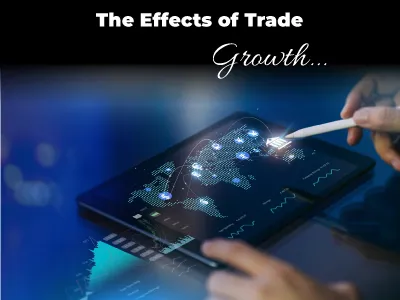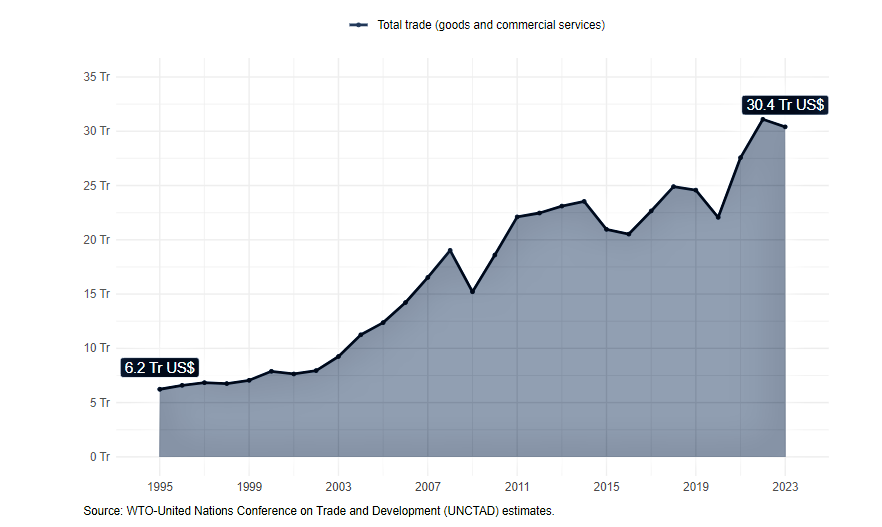
Thirty Years of Trade Growth and Poverty Reduction
Since the signing of the Marrakesh Agreement establishing the World Trade Organization on 15 April 1994, global trade has increased, reaching over USD 30.4 trillion in 2023, a fivefold increase since 1995.
Under the auspices of the WTO, tariffs have seen a significant decline, thereby lowering trade costs. This trade growth, coupled with the substantial reduction in poverty worldwide, underscores the pivotal role of trade in fostering economic development and enhancing people's lives.
Significant Growth in Trade in Goods and Services
When the WTO was established 30 years ago, the aim was to create a new global order based on openness, inclusiveness, and cooperation. Established as the successor to the General Agreement on Tariffs and Trade (GATT), which dealt mainly with trade in goods, the WTO covers trade in services and intellectual property to help its members use trade to raise living standards, create jobs, and improve people's lives.
The 30 years since the establishment of the WTO have ushered in a new era of trade and economic growth. Between 1995 and 2023, total world trade—in goods and commercial services—grew at a robust average annual rate of 5.8 percent, representing a nearly five-fold increase.
Notably, the growth trajectory of trade in services outpaced that of goods, demonstrating a shift in global trade patterns. Trade in commercial services witnessed a robust average annual growth rate of 6.8 percent, while trade in goods recorded a slightly lower increase of 5.5 percent.
World trade growth outpaced global gross domestic product (GDP), which increased by an average of 4.4 percent per year over the same period. After rising from 20 percent in 1995 to 31 percent in 2022, global trade as a share of GDP showed a significant upward trend, falling to 29 percent in 2023, as trade in goods declined in value on a balance of payments basis.
This suggests that the interconnectedness of economies through trade is increasing despite temporary declines during the global financial crisis of 2008-09 and the COVID-19 pandemic in 2020.
The Share of Services in Trade- Especially Digitally Delivered Services- Increases
The past three decades have also witnessed an increasing share of services in global trade.
Thus, commercial services' share of world trade increased from 19 percent in 1995 to 25 percent in 2023. It should be noted, however, that these figures do not consider trade in services under mode 3 of the General Agreement on Trade in Services, which includes local sales by resident subsidiaries of foreign service companies.
As a result, these figures significantly underestimate the true extent of service activities in global trade. According to the WTO's latest estimates, she recently presented in the Global Trade Outlook and Statistics, the share of services in international trade in 2022 approaches 42 percent when mode three trade in services is included.
Share of Trade between Emerging Economies Increased Significantly
Over the last three decades, the rapid economic growth driven by trade in developing and emerging economies has significantly transformed trade patterns, particularly with global trade growth among developing economies.
Trade among emerging economies has increased by 9.7 percent annually, from less than one-tenth of global trade in 1995 to nearly 25 percent in 2022, totaling USD 6.1 trillion.
In contrast, trade between advanced economies accounted for more than half of global trade in 1995. Still, by 2022, this share had fallen to 39 percent, confirming a relative shift in trade flows toward developing and emerging economies.
Tariffs and Trade Costs Reduced
Since the establishment of the WTO in 1995, tariffs have been markedly declining. The simple rage tariff applied by WTO members on a Most Favoured Nation (MFN) basis (where WTO members accord all other WTO members the same trade treatment, including tariff rates and market access) has fallen from 13.1 percent to 8.8 percent.
A similar trend emerges for tariffs applied on a trade-weighted basis, with the average MFN tariff falling from 7.1 percent to 3.8 percent. Between 1996 and 2022, the trade-weighted average of applied tariffs declined from 6.9 percent to 2.0 percent, assuming full use of preferential tariffs.
Increased Trade Coincides with a Sharp Decline in Global Poverty
Between 1995 and 2022, low—and middle-income economies increased their share of global exports from 17 percent to 32 percent. Over this period, these economies with incomes below US$2.15 per day saw a significant decline in the proportion of their population living on less than US$2.15 per day. This figure fell from 40 percent in 1995 to 10 percent in 2022, demonstrating trade's positive impact on poverty reduction and economic development in these regions.

 Back
Back








